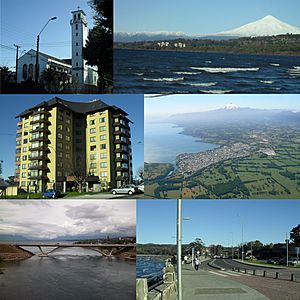Villarrica, Chile facts for kids
Quick facts for kids
Villarrica
|
|||||
|---|---|---|---|---|---|
 |
|||||
|
|||||
| Country | Chile | ||||
| Region | Araucanía | ||||
| Province | Cautín | ||||
| Founded | 1552 | ||||
| Founded as | Santa María de Magdalena de Villa Rica | ||||
| Government | |||||
| • Type | Municipality | ||||
| Area | |||||
| • Total | 1,291.1 km2 (498.5 sq mi) | ||||
| Elevation | 227 m (745 ft) | ||||
| Population
(2012 Census)
|
|||||
| • Total | 49,184 | ||||
| • Density | 38.0946/km2 (98.665/sq mi) | ||||
| • Urban | 30,859 | ||||
| • Rural | 14,672 | ||||
| Demonym(s) | Villarrican | ||||
| Sex | |||||
| • Men | 22,694 | ||||
| • Women | 22,837 | ||||
| Time zone | UTC−4 (CLT) | ||||
| • Summer (DST) | UTC−3 (CLST) | ||||
| postal code |
493 0000
(assigned but not in use as of 2006) |
||||
| Area code(s) | country + city = 56 + 45 | ||||
| postal code precedes City name, e.g. 493 0000 Villarrica |
|||||
Villarrica is a city and commune in southern Chile. It is located on the western shore of Villarrica Lake. The city is in the Province of Cautín, within the Araucanía Region. It is about 746 kilometers south of Santiago.
Villarrica is also close to the Villarrica Volcano ski center. People from Villarrica are called Villarricences.
The main ways people make a living here are tourism, farming (grains and dairy), and forestry. The weather is usually mild and humid. Most rain falls between May and July. The driest time is from December to February.
Contents
Fun Activities and Nature
Many beautiful lakes are near Villarrica. These include Calafquén, Caburgua, Huilipilún, and Colico. In summer, water sports and sunbathing are very popular. The temperatures are warm, and the area is not very high above sea level.
You can also enjoy fishing and rafting in the local rivers. Some of these rivers are the Toltén, Voipir, Trancura, Llancahue, and Lincura. There are also cool waterfalls like León, La China, Palguín, and Ojos del Caburga.
Because of the many volcanoes nearby, there are natural hot springs. Their water can be very warm, from 48°C to 90°C. Some popular hot springs are Coñaripe (48°C), San Luis (43°C), Huife (49°C), Palguín (57°C), and Liquiñe (87°C).
The Villarrica National Park is about 36 kilometers away. It was created to protect the volcano's natural beauty. Many buildings in this area are made mostly of wood.
History of Villarrica
Villarrica was first founded in 1552. It was named Santa María Magdalena de la Villa Rica, which means Saint Mary Magdalene of Richville. Jerónimo de Alderete founded it. The first location was probably near where Pucón is today.
In its early years, Villarrica was important for mining gold and silver. But the mining slowed down. This happened because mudflows from the Villarrica Volcano covered the gold deposits. So, the city was moved west to its current spot. This new place was safer from volcanic dangers.
After Alderete died in 1554, the city was left empty. But five years later, García Hurtado de Mendoza refounded it. It grew into a small city. It even survived a big earthquake on December 16, 1575. The city also started trading with Buenos Aires.
During the Arauco War, Villarrica was the last Spanish city south of the Bío Bío River. It was under attack for three years. On February 7, 1603, the city gave up. Before this, it had over 600 Spanish people living there. Only 11 men and 13 women were taken captive.
The city was refounded again in the 1880s. This happened during the occupation of Araucanía. Since then, Villarrica has grown a lot. It is now known around the world as a great place for tourists. People come for nature, summer fun, and winter sports.
After the city was refounded, the Chilean government wanted more people to settle there. They sold land and invited immigrants from Europe. Many Swiss, German, and Austrian families came in the late 1800s.
Population Information
In 2002, Villarrica had 45,531 people living there. This included 22,694 men and 22,837 women. About 30,859 people (67.8%) lived in city areas. The other 14,672 people (32.2%) lived in rural areas. The population grew by 26.9% between 1992 and 2002.
How Villarrica is Governed
Villarrica is a commune, which is a local government area in Chile. It is managed by a municipal council. The head of the council is an alcalde (mayor). The mayor is chosen directly by the people every four years. The mayor in 2021 was Germán Vergara Lagos.
See also
 In Spanish: Villarrica (Chile) para niños
In Spanish: Villarrica (Chile) para niños




